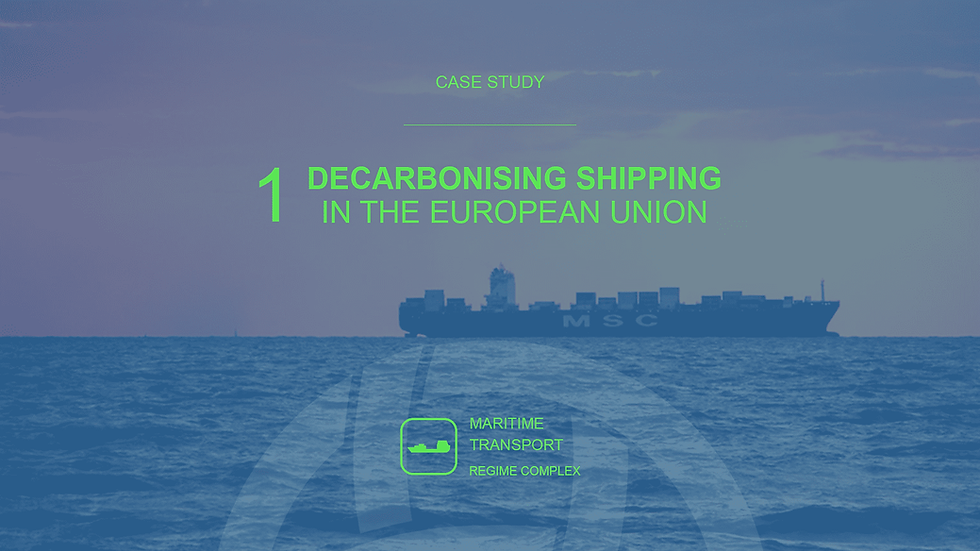Decarbonising Shipping in the EU: An introduction to Case Study 1
- pavel874
- Aug 3, 2023
- 3 min read
Updated: Nov 5, 2023

Global shipping emits 2.8-3.0% of all greenhouse gases (GHGs) but the sector is left out of the Kyoto Protocol and Paris Agreement. The International Maritime Organization (IMO) was asked to develop climate policies, and while it adopted the ambition to reduce GHGs by half by 2050 (compared to 2008), in its measures the focus is primarily on energy efficiency. Decarbonisation measures such as alternative fuels or electrification are foreseen to be on IMO’s agenda only after 2030.
The shipping industry is characterised by power imbalances which affects IMO’s decision making. Powerful flag states and ship-industry organisations (e.g. Chamber of International Shipping) hamper ambitious climate targets and measures. In this context, calls are growing louder for the EU to become more proactive.
To keep track of and reduce GHG emissions from shipping, the EU has adopted the Monitoring Reporting and Verification regulation that requires ships over 5000 gigatons to report their fuel use and GHG annually. The EU also incorporated shipping into the EU Emission Trading Scheme.
To advance the decarbonisation agenda, multiple partnerships have emerged with co-leads in Europe and beyond e.g. the Zero-Emission Shipping Mission, Getting to Zero Coalition, Poseidon Principles. Moreover, incentives now exist for the shipping industry to decarbonise, from climate-friendly fuels to new propulsion systems and ship engines.
Scope
This case study covers the whole of the EU and focuses on
EU-wide decarbonisation policies that affect shipping practices
The role of cargo owners in implementing these policies and in shaping decarbonisation of the shipping sector
The global nature of shipping and the EU´s remit in regulating EU ship owners (and their flagged ships) means that the targeted actors of EU decarbonisation measures extend to all ships coming into EU ports as well as EU flagged ships that operate outside of the EU. It is therefore not only Member States and their ship owners, builders, ports and cargo owners that are affected, but also those from outside the EU that trade with it.
As regards decarbonisation measures, the case study will investigate two specific pathways: 1) reduction of GHG emissions through energy efficiency and shipping optimisation, and 2) energy transition to alternative fuels or propulsion systems.
Assumptions
The case study will test three assumptions:
Shippers, especially consumer facing shippers, have stronger incentives and want a faster pace of reducing shipping’s GHG emissions than ship owners; this incentive will only grow with the implementation of sustainability reporting requirements set by the EU
GHG reporting will help shippers to include criteria around GHG emissions in their decision making when chartering/contracting ships
Since shipping is one of several modes of transport in moving goods from A to B, energy efficiency trade-offs between different modes are taken into account by shippers; an option that is deemed the most energy efficient for one shipping voyage or route, might not be the most efficient for a shipper
Research questions
The case study aims to answer the following research questions which broadly fall into two categories: governance and e-governance.
Governance | E-Governance |
What are the institutional barriers (including lack of regulation) that limit existing EU policies to decarbonise shipping in the context of climate neutrality and sustainable mobility enshrined in the EU Green Deal? Which institutional barriers are embedded within policy design of IMO and EU measures that aim to decarbonise shipping, and how does this impact policy implementation within the maritime transport regime complex and its ability to achieve EU Green Deal objectives? Which institutional barriers exist in the IMO and EU governance arrangements that focus on developing and implementing decarbonisation measures for shipping? | What is the role of technology in helping shipping to decarbonise and achieve EU Green Deal objectives? How can the increased availability of harmonised GHG emissions data from shipping enhance the involvement and influence of shippers towards EU policies that aim to decarbonise shipping? How has the concept of e-governance been applied to the reduction of GHG emissions from shipping and to the maritime transport more broadly, especially when compared with traditional e-government areas like public services, in terms of the underlying digital tools and interventions used, data, end users, and overall effectiveness? |
PERMAGOV partners
The case study is managed by the Centre for Blue Governance in cooperation with the European Shippers Council (ESC). For ESC, the case study presents an opportunity to share the voice of shippers on the important and challenging development that is decarbonisation. At the same time, new research knowledge gained from the case study will help ESC to shape its future positions on various shipping measures related to the EU Green Deal.
Connections with other case studies
Motorways of the Sea (Case Study 2): This case focuses on the EU policy to replace road/rail transport with short sea shipping within the EU. This can potentially increase shipping emissions at an EU level, and is likely to impact transport choices made by shippers
Marine Energy Complex (Case Studies Five, Six, Seven): Renewable energy technologies are poised to transform shipping at different levels and scales, so a potential link exists with these case studies as they focus on the future energy provision from green energy sources
Marine Litter in the Baltic Sea (Case Study 8): This case study focuses on litter from fisheries and lost cargo and so is relevant to shipping







Comments